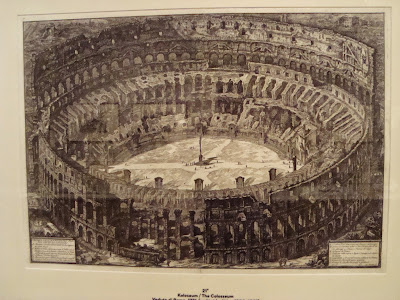 |
|
Carceri
Image courtesy
of: http://www.ngprague.cz
|
Much to my surprise at the end of last year I
began to see posters for a Piranesi exhibition in Prague. I immediately though who
and why had someone decided to introduce this seminal Italian etcher to a wider
Czech public. I had always associated his works with regions west of the Czech
Republic.
 |
|
One of the handsome tile stoves
|
I have finally had a chance to see the
exhibition and was not disappointed at all. Shown in the appropriately fitting
surrounding of the Clam Gallas palace the curators have done their best to
bring Piranesi‘s baroque impressions to life in a realistic setting. The original
ceiling high tile stoves in the exhibition rooms which have elements of
classical architecture complement the engravings of the classical buildings being
shown. The Clam Gallas palace itself was inspired by engravings such as these
alluding to the grandeur of aristocratic residences. Much of the exhibition is
from Czech collections.
 |
| McMansion ? |
Giovanni Battista Piranesi’s work is presented in its full spectrum covering almost all
the major themes he depicted. Each theme is displayed in a different room from
his maps of imaginary cities to his romantic ruins and to the detailed
engravings of antiquities.
 |
|
A bit of Wedgewood inspired
heating
|
His
“views or Vedute“ are some of his famous
works on show. They represent mythical cities and lands where fantasy and
reality mix in an almost comical manner. His cities are places that were once
glorious but whose monumental building are falling apart .Many of the cityscapes in
the exhibit depict what was or could have been Rome of the 18th century ,the
way the grand tourists saw it. Needless
to say this connection to the grand tourists has been one of the keys to his
long lasting popularity.
 |
|
A city that once was.
|
For Piranesi architecture in all forms is a
lot more important than people as if reminding viewer that “’people die but
buildings are immortal “.Piranesi’s buildings are in fact vast structures most often
in the classical example of ancient Rome. His fortresses show strength; his
palaces give the impression of power, while the bridges he engraved leave one
feeling there is a link to the past. And if his allusions to ancient Rome are
not enough he added symbols from old Egypt to reinforce the message. Last but
not least all his buildings tower over his human subjects reducing them to tiny
details within the whole composition.
 |
|
The Colosseum as experienced by the grand tourist.
|
People in his engraving are almost always men,
often ragged and wretched and shown in a state of utter misery. The vagrants,
beggars and vagabonds all seem to be in a state of commotion or physical despair,
pointing to towards an illusionary source of help. They are lost characters
trying to escape doom .The few who are not falling into some sort of hell all
look like the aristocrats who might have bought Piranesi’s engravings. Since at
the time there were few female grand tourists, women appear only as hints of
Greek goddesses.
 |
|
Something industrial.
|
A whole room is dedicated to his depictions of
concocted prisons which he was famous for. These truly “gothic “images of water
filled dungeons bring to mind a sort of illustration for Franz Kafka’s work who
grew up right behind the corner.
 |
|
Piramide di Caio Cestio.
Image courtesy of: http://www.piranesiselection.com
|
The exhibit is a much needed temporary
addition to the local cultural scene and is especially rewarding in the
interiors of the Clam Gallas palace .It
is easy to see how he influenced successive generations of artists from the Romantics to the Victorians to the more recent surrealists.
